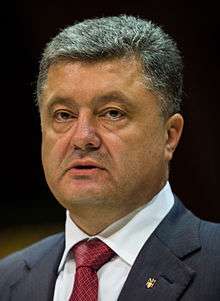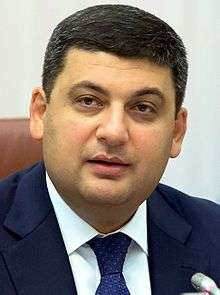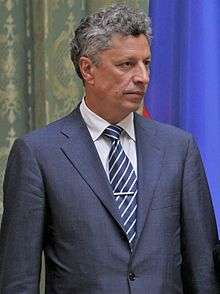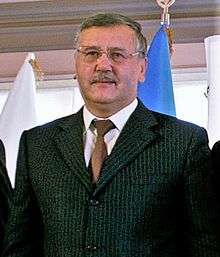Ukrainian parliamentary election, 2019
| | ||||||||||||||||||||||||||||||||||||||||||||||||||||||||||||||||||||||||||||||||||||||||||||||||
| ||||||||||||||||||||||||||||||||||||||||||||||||||||||||||||||||||||||||||||||||||||||||||||||||
| ||||||||||||||||||||||||||||||||||||||||||||||||||||||||||||||||||||||||||||||||||||||||||||||||
| ||||||||||||||||||||||||||||||||||||||||||||||||||||||||||||||||||||||||||||||||||||||||||||||||
The next Ukrainian parliamentary elections must be held no later than 2019. Due to the March 2014 annexation of Crimea by Russia and the occupation of parts of Donetsk Oblast and Luhansk Oblast by separatists (since April 2014) only 423 of 450 seats in Verkhovna Rada can currently be elected under current election laws.
Background
Following the 2014 parliamentary elections the Petro Poroshenko Bloc (PPB) party became the largest party, after securing 132 seats. On 21 November 2014, Petro Poroshenko Bloc, People's Front, Self Reliance, Fatherland and the Radical Party signed a coalition agreement.[1] Arseniy Yatsenyuk became Prime Minister on 2 December 2014.
Radical Party left the coalition on 1 September 2015 in protest over a vote in parliament involving a change to the Ukrainian Constitution that would lead to decentralization and greater powers for areas held by pro-Russian separatists.[2] February 2016 saw the start of the fall of the Yatsenyuk cabinet after economy minister Aivaras Abromavičius announced his resignation claiming the government did not had a real commitment to fight corruption.[3] 17 and 18 February 2016 Fatherland and Self Reliance left the coalition; meaning that the coalition became 5 deputies short of the 226 needed.[4] On 14 April 2016 Volodymyr Groysman became the new Prime Minister and the Groysman government the new cabinet of ministers.[5]
Electoral system
Under current election laws 50% or 226 members of the Verkhovna Rada are elected by open party-list proportional representation with 5% electoral election threshold and the other 50% of the seats elected in 225 constituencies with a first-past-the-post electoral system in one round (candidate with the highest vote total wins).[6][7][8][9] Since 2014 in Ukraine negotiations on the introduction of 100% Party-list proportional representation elections with open lists.[6] Main lobbyists: Volodymyr Groysman, Self Reliance. Main opponents: Yulia Tymoshenko.[10]
Opinion polls
References
- ↑ Five political forces sign coalition agreement, Interfax-Ukraine (21 November 2014)
Ukraine's parliamentary parties initial coalition agreement, Interfax-Ukraine (21 November 2014) - ↑ Ukraine Radical Party Quits Ruling Coalition After Deadly Clash, Bloomberg News (1 September 2015)
- ↑ Ukraine Economy Minister decides to resign, UNIAN (3 February 2016)
- ↑ Samopomich pulls out from ruling coalition in parliamen, Interfax-Ukraine (18 February 2016)
(Ukrainian) "Self" comes from the coalition, Ukrayinska Pravda (18 February 2016)
Batkivschyna faction pulls out of coalition, UNIAN (17 February 2016)
Batkivshchyna faction leaves ruling coalition, Kyiv Post (17 February 2016) - ↑ "Ukraine MPs approve Volodymyr Groysman as new PM". BBC News. 14 April 2016. Retrieved 14 April 2016.
- 1 2 Electoral dead-end for Rada, UNIAN (29 September 2016)
- ↑ "Parliament passes law on parliamentary elections". Kyiv Post. Interfax-Ukraine. 17 November 2011. Retrieved 9 August 2015.
- ↑ "Ukraine: The Law on Election of the People's Deputies (Unofficial translation by IFES), 2011" (PDF). 17 November 2011. Retrieved 8 August 2015.
- ↑ The Distorted Will of the People, The Ukrainian Week (5 November 2012)
- ↑ https://focus.ua/country/302623/





